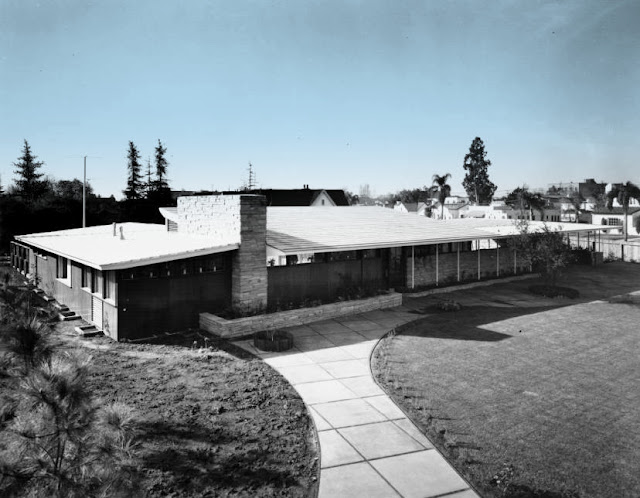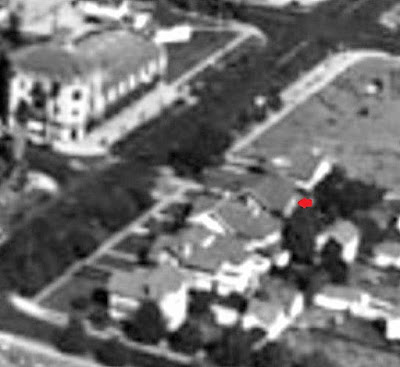
Introduction and Inventory
PLEASE SEE OUR COMPANION HISTORIES
A CENTURY BEFORE THE CIVIC MINDSET of Los Angeles turned determinedly urban and vertical, there was the original four-block stretch of Wilshire Boulevard. At once a radical concept and the demesne of plutocrats, the nascent thoroughfare's initial incarnation between MacArthur and Lafayette parks reflected perfectly its progenitor, eccentric socialist millionaire Gaylord Wilshire, he of the luxuriant Van Dyke beard and knowing eyes. As the city suburbanized beyond its core, today undergoing a surprising rebirth, the trend was toward the southwest. The builders of large houses forsook the steep slopes and narrow lots of close-in (and now vanished) residential Bunker Hill for the horizontal stretches in the direction of the University of Southern California, established in 1880. To this day Americans are caught up with the idea of establishing their own fiefdoms, with manor house, however big or humble, with gardens and, of course, gates. With the trend toward the expanding West Adams district naturally being led by men with money, the residential future of Los Angeles seemed set. Into the vast expanse of barley fields and semi-desert wilderness limited only by the Pacific, Angelenos would find their roomy individual patches for a new, anti-Eastern way of living. And so it happened. With the establishment of St. James Park (1887) and Chester Place (1899), the genteel die was cast: instant, fresh development, antithetical to the idea of gentility except in a place where everyone was new. The quality and scale of the development of even the more modest tracts surrounding the bon ton enclaves of the Adams District were high enough to give the impression of a God-ordained, has-always-been-here, will-always-be-here cityscape. Enter Mr. Wilshire to challenge any such complacency of West Adams mind.
 |
| Henry Gaylord Wilshire, 1924 |
Born in Cincinnati to rich parents in 1861, Wilshire seems refreshingly to have had no abiding sense of allegiance to haute bourgeois expectations. His ideas were his own. Neither a native Californian nor a particularly committed one—he would live in and out of the state for many periods after first arriving in Los Angeles in 1884—Wilshire never thought of a scheme he didn't implement. Over the course of his 66 years, he grew grapefruit, mined gold, and peddled bogus (if not to him) electrical health belts. He was a politician of carpetbagger stripe, running for Congress in California at least twice and then again in New York, for California attorney general, and for both the Canadian and English parliaments. He published magazines, Wilshire's Monthly among them, the most widely read socialist journal in the decade after the turn of the 20th century. All the while an active member of the über-haute-bougie California Club and the Los Angeles Country Club, he defied established residential fashion by developing a barley field not in the fashionable southwestern districts of the city, but in a direction more directly west of First and Main. Deliberately secluded on the far side of Westlake Park (renamed for General Douglas MacArthur in 1942), Wilshire caught in his development's net two big California Club cronies: militaristic fantasist General Harrison Gray Otis, the virulent civic booster who was also the virulently anti-unionist publisher of the Los Angeles Times, and Edwin Tobias Earl, whose invention of the climate-controlled rail car revolutionized California agriculture by introducing oranges and broccoli to the world. Otis, whose downtown newspaper office was "The Fortress," took pride of place, building his "Bivouac" at 2401 Wilshire in 1897; two years later Earl completed his house next door at 2425—like Saks Fifth Avenue and Neiman Marcus in a mall, anchor tenants. It would take a couple of decades for West Adams in its turn to begin to feel cramped—the city's population well more than doubled in the 1920s and the resulting rise in land values prompted property owners to move on to Windsor Square, Hancock Park, Pasadena, and the wide-open Westside—but the district did finally lose favor as Los Angeles's "uptown" district. Unknowingly, it seems, Gaylord Wilshire had steered developing Los Angeles west toward a decade-distant bean field called Beverly Hills, toward which and around which prosperous Los Angeles would eventually settle.
 |
| The original foot of Wilshire Boulevard from today's MacArthur Park presented a scene of just-born American architectural electicism: Along the north side of the street, circa 1900, are General Harrison Gray Otis's Mission-style "Bivouac" at 2401, Edwin T. Earl's Ernest Coxhead–designed English manor at 2425, and the transitional Victorian–Colonial Revival pile of Dr. Henderson Hayward at 2501. |
Gaylord Wilshire's original eight square blocks are all that he was directly responsible for. His 1895 development of 35 acres west of Westlake Park with his San Francisco–based brother William Benton Wilshire included the donation to the city of Los Angeles of a 120-foot-wide strip of land for a bisecting boulevard, a donation dependent on the road being named for him and on the stipulation that no railroad or commercial trucking would be allowed. Such was the success of the small development, and of the allure to Americans of any name ending in "-shire," that the idea was seized upon and run with by other even more gobbling developers, all the way to the Pacific. The Wilshire cachet was also enough for property owners along Orange Street—the Boulevard's gridmate directly in line across the park—to ask that its name be changed to Wilshire Boulevard in 1924, their success resulting in Wilshire's extension east to Grand Avenue that year. Finally, in 1934, a causeway through Westlake Park completed Los Angeles's 16-mile trans-city civic emblem, even if it didn't make for consistency. As Los Angeles Times architecture critic Christopher Hawthorne has put it, "No, rather than act as a perfect symbol of Los Angeles, Wilshire has operated as a proving ground for new ideas about architecture, commerce, transportation and urbanism in Southern California.... Wilshire is our boulevard of cold feet and second thoughts, the place where [the city] confronts its deep ambivalence about putting a low-rise, car-dominated and essentially suburban past behind it for good.... The result on today's Wilshire is a lurching, piecemeal utopianism that can take you from a world-famous piece of architecture to a weed-choked lot, from a realized ambition to an abandoned one, in the space of a few blocks." (See Hawthorne's excellent history of the boulevard here.)
 |
| While adding an "L" in error, the 1910 Baist real estate atlas offers a colorful view of the original eight square blocks of the Wilshire Boulevard Tract neatly placed between Sunset (now Lafayette) and Westlake (now MacArthur) parks. While Gaylord Wilshire placed permanent restrictions against street railways on the boulevard (and any extension of it) when he donated the strip to the city, he was careful to gain transportation franchises running along Sixth and Seventh streets from downtown to his then-isolated subdivision. |
While Gaylord Wilshire's own residential idea was not of a linear nature, linear is what the extension of his residential boulevard became. Although the fashionable larger "Wilshire District"—now dominated by Koreatown—developed rapidly, a Boulevard address only temporarily usurped the preeminence of one in West Adams. As its residential pattern developed linearly toward the true west of Los Angeles, toward quieter new districts such as Windsor Square and the independent Beverly Hills and ultimately to the City of Los Angeles's annexations beyond that city, Wilshire began to fail as a residential avenue. The Wilshire Boulevard of homes was of limited life, even if it became even more famous—much more famous—as a commercial thoroughfare.
Initially, at least, the limits of our discussion here are of the residential boulevard from Harrison Gray Otis's "Bivouac" once at the northwest corner of Park View Street, to Highland Avenue, and not the road's present full length east and west, parts of which, of course, are residential though in a starkly highrise vein. We have so far identified 95 houses (including some on the Boulevard but modestly addressed on side streets), and are in the process of telling the story of each. While a surprising number of Wilshire Boulevard houses have revealed themselves in pictures, even if obliquely, more of them than we had hoped for, there are some "holdouts"—just as, it might be said, there are actual holdouts of still-extant original dwellings, those to be revealed as the stories unfold.
Below you will find our pictorial inventory in which links lead to the story of each house, sequentially west from MacArthur Park. For a view forward to early post-residential Wilshire Boulevard, please see "Wilshire After Its Houses" here.
§ § § § § § § § § §
Below you will find our pictorial inventory in which links lead to the story of each house, sequentially west from MacArthur Park. For a view forward to early post-residential Wilshire Boulevard, please see "Wilshire After Its Houses" here.

2425 Wilshire Boulevard: The Edwin Tobias Earl House
2515 Wilshire Boulevard: The Effie Gardner Neustadt House

2619 Wilshire Boulevard: The Higgins / Rand / Verbeck House
2706 Wilshire Boulevard: The Eager / Stewart House

2711 Wilshire Boulevard: The Ella and George Ruddy House
CLICK HERE FOR FULL STORY
CLICK HERE FOR FULL STORY
2720 Wilshire Boulevard: The Dent House
CLICK HERE FOR FULL STORY

2721 Wilshire Boulevard: The Gardner / Latz House
CLICK HERE FOR FULL STORYThe southwest corner of Hoover Street, 1927
655 Wilshire Place: The Albert R. Maines / Emma Summers House
3033 Wilshire Boulevard: The William C. Price House
3043 Wilshire Boulevard: The Walter Harrison Fisher House
3077 Wilshire Boulevard: The Gilbert S. Wright House
3087 Wilshire Boulevard: The Lowman / Blaisdell / Burnap House
3101 Wilshire Boulevard: The Neustadt / Monnette / Bain House
3173 Wilshire Boulevard: The Brodtbeck / Wheeler House
3189 Wilshire Boulevard: The Ida Hancock Ross House
641 South Vermont Avenue: The Joseph and Herman Burkhard House
3200 Wilshire Boulevard: The William Lacy / John G. Bullock House
646 South New Hampshire Avenue: The Oscar Lawler House
666 South Berendo Street: The Earle C. Anthony House
3300 Wilshire Boulevard: The Charles E. Anthony House
3325 Wilshire Boulevard: The Solomon Aronson House
3440 Wilshire Boulevard: The Ruben S. Schmidt Houses

3580 Wilshire Boulevard: The Charles M. O'Leary House
3644 Wilshire Boulevard: The Walters / Chaffey / Kellam House
651 South Hobart Boulevard: The Andrew Getty / James A. Talbot House
3828 Wilshire Boulevard: The Fred Eaton / Ruth Roland House
3834 Wilshire Boulevard: The Kloeb / Pauly / Gelder House
3840 Wilshire Boulevard: The Rice / Escallier / Eisenhauer / Barton House
647 South Manhattan Place: The William B. Sylvester House
3846 Wilshire Boulevard: The Hilda B. Jenkins House
3852 Wilshire Boulevard: The Gernert / Schulze / Jones House
3932 Wilshire Boulevard: The Wendall H. Sutch House
CLICK HERE FOR FULL STORY
3968 Wilshire Boulevard: The Schlank / Yorba / Holland House
3974 Wilshire Boulevard: The Frank Borzage House
645 South Wilton Place
CLICK HERE FOR FULL STORY
4011 Wilshire Boulevard
CLICK HERE FOR FULL STORY
4015 Wilshire Boulevard
CLICK HERE FOR FULL STORY
4032 Wilshire Boulevard: The Blyth / Keith House
4036 Wilshire Boulevard
4037 Wilshire Boulevard: The Akin / Wagner House
4056 Wilshire Boulevard
4128 Wilshire Boulevard: The Allan W. Black / Anna Stine House
701 South Windsor Boulevard
CLICK HERE FOR FULL STORY
700 South Plymouth Boulevard: The Robert A. Copple House
CLICK HERE FOR FULL STORY
4451 Wilshire Boulevard: The Judge Charles S. Crail House
4472 Wilshire Boulevard: The Parsons / Kice / Banton House
644 South Rossmore Avenue: The Jackson Barnett House
21 Fremont Place: The Morris Harris House
4526 Wilshire Boulevard: The William I. Gilbert House
4536 Wilshire Boulevard: The Felix Duenkel House
4622 Wilshire Boulevard
4628 Wilshire Boulevard

4656 Wilshire Boulevard: The William Robins Flood House
707 South Tremaine Avenue: The Raphael Alexander House
700 South Longwood Avenue: The John R. Reilly House

4950 Wilshire Boulevard: The Post-War House
Illustrations: Los Angeles Public Library; James Colin Campbell;
Historic Map Works; others credited in individual articles





































































































